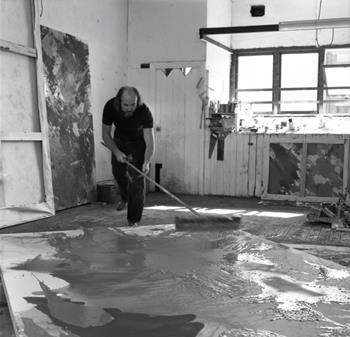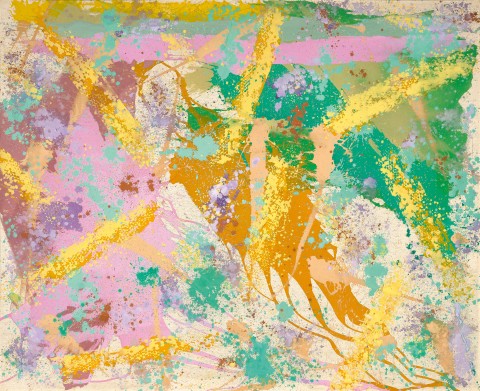MANASSAS BLUE, 1973
SYDNEY BALL
synthetic polymer paint on canvas
198.0 x 244.5 cm
signed, dated and inscribed with title verso: ‘MANASSAS BLUE’ / SYDNEY BALL 1973
Bonython Gallery, Sydney
National Australia Bank Collection, acquired in 1975 (label attached verso)
Paintings by Sydney Ball, Bonython Gallery, Sydney, 17 March – 3 April 1973
The Seventies: Australian Paintings and Tapestries from the Collection of National Australia Bank, National Gallery of Victoria, Melbourne, 15 October – 28 November 1982
The Seventies: Australian Paintings and Tapestries from the Collection of National Australia Bank, Geelong Art Gallery, Victoria, 30 April - 29 May 1988
Thomas, D., ‘Sydney Ball Joins Revival’, Sydney Morning Herald, Sydney, 22 March 1973, p. 31
Lindsay, R., The Seventies: Australian Paintings and Tapestries from the Collection of National Australia Bank, The National Bank of Australasia, Melbourne, 1982, pl. 4, p. 17 (illus., as ‘Manassis Blue’)
Taylor, P., Anything Goes: Art in Australia 1970 – 1980, Art & Text, Melbourne, 1984, p. 43 (illus., as ‘Marnassis Blue’)
SYD BALL (oly res I can find).jpg

Pioneering abstract painter Sydney Ball wrote of the expansive and sensuous Manassas Blue, one of his first ‘Stain Paintings’ which featured in a sell-out exhibition in Bonython Galleries in March 1973:
‘Manassis [sic.] Blue was one of a group of paintings completed in 1972 on my return from New York where I lived from 1969 – 1971. The format of the work was influenced by my years in New York and the need to re-evaluate the role of colour in my paintings… the loosening up of the surface and a new way for colour to organise the structure of the picture. […] in Manassas Blue the way in which the paint is absorbed into the fibre of the [cotton] duck by pouring, rolling and brushing, emphasises both the two-dimensional surface and the richness of the colour’.1
Although Sydney Ball had remarkable success of with his early, New York influenced Hard Edge abstract paintings, which pioneered colour field practice in Australia in the mid-1960s (in particular his circular Canto series and semi-sculptural Modular painted constructions) the artist found himself in 1971 taking a sharp turn into full-blown gestural abandonment. Joyous and vibrant, the explosive nature of these large canvases demonstrated Ball’s astounding agility and inventiveness, unselfconsciously embracing what Daniel Thomas qualified at the time, in March 1973, as an ‘abstract expressionist revival’2, one which Ball, as a mature geometric abstractionist had surprisingly joined. However, this was not so drastic a change as it would seem. It can be read as a logical continuation of Ball’s chief concern with a painting’s planar surface and the explorations of colour and the effects of particular spatial orchestrations on the canvas.
The people and concepts that Sydney Ball had encountered during his second sojourn in New York had a profound effect on the ‘Stain Paintings’ that he produced in 1972, ‘eventually brought forward these present paintings of high calibre’.3 The sense of urgency and immediacy of visual effect that was hitherto found in Ball’s severe surfaces, was now translated into mottled action paintings, informal and ethereal. Manassas Blue displays all of the attributes of American critic Clement Greenberg’s Post-painterly abstraction: a thinned acrylic paint (borrowed from Mark Rothko and Helen Frankenthaler’s stained oil washes in New York, whom Ball had worked alongside), a raw and unprimed canvas left bare in places and non-uniform poured areas of pure rich colour (the optical effects of which Ball had appreciated in the works of Kenneth Noland).4
While some of Ball’s early Stain paintings, bore the bar-shaped forms of past works, those painted in Sydney were not only brighter in their hue, but contained no straight edges at all. Manassas Blue has a series of superimposed splashes of paint, with the illusion of transparency creating a complex ordering. These layers are crowned by uneven diagonal bands of rolled pale yellow strips which now replaced Ball’s stencilled bars. Although this work, like the others in the first stain series, was produced lying the canvas flat on the floor of the studio, painted by pouring buckets of pure colour on to its surface, the artist did specify with hand drawn arrows verso, which way the painting was to be orientated once completed.
Manassas Blue was exhibited in early 1973 in Ball’s first exhibition at Bonython Galleries in Sydney after his return to Australia. The technical bravura of these paintings was reinforced in their bold presentation in this gallery, with Ball covering its walls with extraordinarily large canvases. The show was described as ‘glamorous and exuberant’ in the press,5 and three paintings were directly acquired for state collections. The title Manassas Blue possibly refers to Manassas, a town in Northern Virginia, USA visited by the artist during a road trip down the east coast of the US with Elwyn Lynn and Patrick McCaughey. Manassas was the site of two major battles during the American Civil War and sits across a pass in the Blue Ridge Mountains, the name of the town meaning ‘basket shaped’ in the local native American language. As his friend McCaughey recently noted, these stain paintings are the most personal that Ball allowed himself to paint, entirely dictated by feeling and surprise revelations.6
1. The artist, 1981, cited in Taylor, P., Anything Goes: Art in Australia 1970 – 1980, Art & Text, Melbourne, 1984, p. 43
2. Thomas, D., ‘Sydney Ball Joins Revival’, Sydney Morning Herald, Sydney, 22 March 1973, p.31
3. McCaughey, P., Art International, 20 October 1974
4. The artist, 2008, cited in Loxley, A., Sydney Ball: The colour paintings 1963 – 2007, Penrith Regional Gallery, Sydney, 2008, p. 14
5. Thomas, ibid.
6. McCaughey, P., Strange Country, Why Australian Painting Matters, The Miegunyah Press, Melbourne, 2014, p. 310
LUCIE REEVES-SMITH
